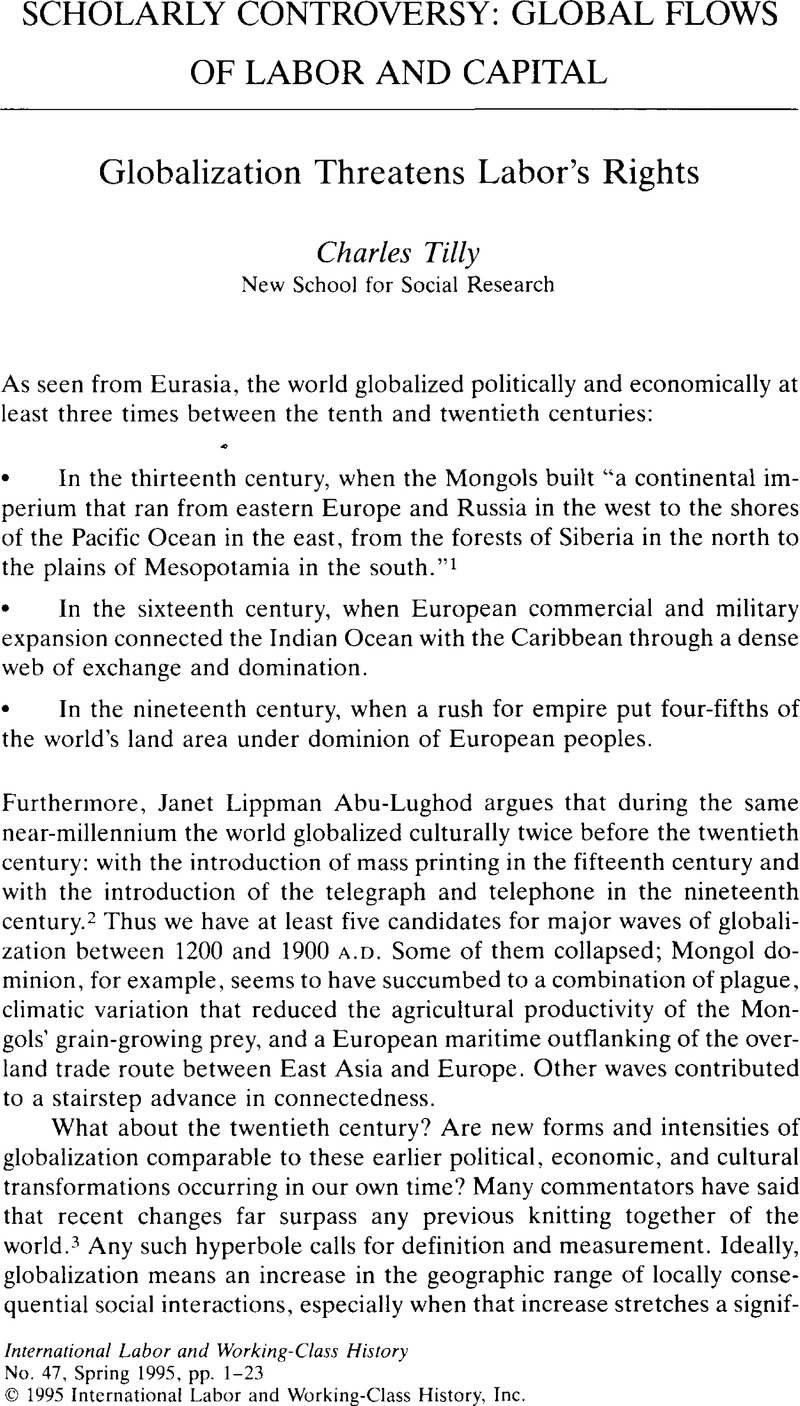No CrossRef data available.
Published online by Cambridge University Press: 16 December 2008

1. Barfield, Thomas J., “The Devil's Horsemen: Steppe Nomadic Warfare in Historical Perspective,” in Studying War. Anthropological Perspectives, ed. Reyna, S.P. and Downs, R.E. (Langhorne, Penn.. 1994), 173.Google Scholar
2. Abu-Lughod, Janet Lippman, “Communication and the Metropolis: Spatial Drift and the Reconstitution of Control,” Asian Journal of Communication 2 (1992): 12–30.CrossRefGoogle Scholar
3. See, for example, Castells, Manuel, “European Cities, the Informational Society, and the Global Economy,” Tijdschrift voor Economische en Sociale Geografie 84 (1993):247–57;CrossRefGoogle ScholarFeatherstone, Mike, ed., Global Culture. Nationalism, Globalization and Modernity (London, 1990);Google ScholarKing, Anthony D., ed., Culture, Globalization and the World-System. Contemporary Conditions for the Representation of Identity (Binghamton, N.Y., 1991);Google ScholarLuard, Evan, The Globalization of Politics. The Changed Focus of Political Action in the Modern World (New York, 1990);Google Scholar and Mittelman, James H., “Global Restructuring of Production and Migration,” in Global Transformation, ed. Sakamoto, Yoshikazu (Tokyo, forthcoming).Google Scholar
4. UNCTAD (United Nations Conference on Trade and Development). World Investment Report 1993. Transnational Corporations and Integrated International Production (New York, 1993), 26;Google ScholarSivard, Ruth Leger, World Military and Social Expenditures 1993 (Washington, D.C., 1993), 43–44.Google Scholar
5. Shah, Nasra M., “Foreign Workers in Kuwait: Implications for the Kuwaiti Labor Force,” International Migration Review 20 (1986):815.CrossRefGoogle ScholarPubMed
6. World Bank, World Development Report 1987 (Oxford, 1987), 39.Google Scholar
7. UNCTAD, World Investment Report 1993, 92–93.
8. Stern, Paul C., Young, Oran R., and Druckman, Daniel, eds., Global Environmental Change. Understanding the Human Dimensions (Washington, D.C., 1992), 47–51.Google Scholar
9. UNCTAD, World Investment Report 1993, 143.
10. World Bank, World Development Report 1993 (Washington, D.C., 1993), 33, 99.Google Scholar
11. UNCTAD. World Investment Report 1993, 14.
12. United Nations, World Economic Survey 1993 (New York, 1993), 20–21.Google Scholar
13. New York Times, 20 March 1994.
14. United Nations, Report on the World Social Situation 1993 (New York, 1993), 17.Google Scholar
15. Gordon, David, “The Global Economy: New Edifice or Crumbling Foundations?” New Left Review 168 (1988):24–65.Google Scholar
16. Hirst, Paul and Thompson, Grahame, “The Problem of ‘Globalization’: International Economic Relations, National Economic Management and the Formation of Trading Blocs,” Economy and Society 21 (1992):357–96.CrossRefGoogle Scholar
17. Ebbinghaus, Bernhard, “Labour Unity in Union Diversity. Trade Unions and Social Cleavages in Western Europe, 1890–1989” (Ph.D. diss., European University Institute, Florence, 1993), 46.Google Scholar
18. Perrot, Michelle, Les ouvriers en grève, 2 vols. (Paris, 1974).CrossRefGoogle Scholar
19. Friedman, Gerald, “The State and the Making of the Working Class: France and the United States, 1880–1914,” Theory and Society 17 (1988):403–30;CrossRefGoogle Scholaridem, “Capitalism, Republicanism, Socialism, and the State: France, 1871–1914,” Social Science History 14 (1990):151–74.
20. Janoski, Thomas, The Political Economy of Unemployment. Active Labor Market Policy in West Germany andhe United States (Berkeley, 1990), 18.Google Scholar
21. Blaschke, Karlheinz, Bevölkerungsgeschichte von Sachsen bis zur industriellen Revolution (Weimar, 1967).Google Scholar
22. Ebbinghaus, “Labour Unity in Union Diversity,” 46.
23. Haimson, Leopold and Sapelli, Giulio, eds., Strikes, Social Conflict and the First World War. An International Perspective (Milan, 1992).Google Scholar
24. Rothstein, Bo, “Labor-market Institutions and Working-Class Strength,” in Structuring Politics. Historical Institutionalism in Comparative Analysis, ed. Steinmo, Sven, Thelen, Kathleen, and Longstreth, Frank (Cambridge, 1992), 39–40.Google Scholar
25. Mann, Michael, The Sources of Social Power II. The Rise of Classes and Nation-States, 1760–1914 (Cambridge, 1993), 59.Google Scholar
26. Grew, Raymond, “The Nineteenth-Century European State,” in Statemaking and Social Movements. Essays in History and Theory, ed. Bright, Charles and Harding, Susan (Ann Arbor, 1984), 101.Google Scholar
27. Cronin, James E., The Politics of State Expansion. War, State and Society in TwentiethCentury Britain (London: 1991), 247.Google Scholar
28. Sivard, World Military and Social Expenditures 1993, 19.
29. van Creveld, Martin, The Transformation of War (New York, 1991).Google Scholar
30. Visser, Jelle and Ebbinghaus, Bernhard, “Making the Most of Diversity? European Integration and Transnational Organization of Labour,” in Organized Interests and the European Community, ed. Greenwood, Justin, Grote, Jurgen R., and Ronit, Karsten (London, 1992), 206–207.Google Scholar
31. Dicken, Peter, Global Shift, The Internationalization of Economic Activity, 2nd ed. (New York, 1992), chap. 7.Google Scholar
32. Ibid., 221, citing Business Week, 3 March 1986.
33. Kriesi, Hanspeter, Political Mobilization and Social Change. The Dutch Case in Comparative Perspective (Aldershot, 1993), 266.Google Scholar
34. Earle, Carville, “Divisions of Labor: The Splintered Geography of Labor Markets and Movements in Industrializing America. 1790–1930,” International Review of Social History 38. supplement 1 (1993):5–38;CrossRefGoogle ScholarHanagan, Michael P., “Introduction [to special issue on ‘Solidary Logics’],”,” Theory and Society 17 (1988):309–28;CrossRefGoogle ScholarMontgomery, David, The Fall of the House of Labor. The Workplace, the State, and American Labor Activism, 1865–1925 (Cambridge, 1987);CrossRefGoogle ScholarVoss, Kim, The Making of American Exceptionalism. The Knights of Labor and Class Formation in the Nineteenth Century (Ithaca, N.Y., 1993).Google Scholar